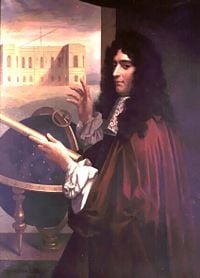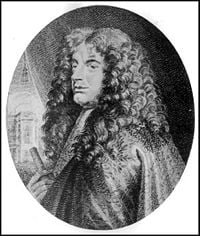Giovanni Domenico Cassini
<<Please flesh out this article and organize it into sections, as with other bios.>>
Giovanni Domenico Cassini (June 8, 1625–September 14, 1712) was an Italian-French astronomer, engineer, and astrologer. Cassini, also known as Giandomenico Cassini, was born in Perinaldo, near Sanremo, at that time in the Republic of Genoa.
Cassini was an astronomer at the Panzano Observatory, from 1648 to 1669. He was a professor of astronomy at the University of Bologna and became, in 1671, director of the Paris Observatory. He thoroughly adopted his new country, to the extent that he became interchangeably known as Jean-Dominique Cassini—although that is also the name of his great-grandson.
Along with Robert Hooke, Cassini is given credit for the discovery of the Great Red Spot on Jupiter (ca. 1665). Cassini was the first to observe four of Saturn's moons, which he called Sidera Lodoicea; he also discovered the Cassini Division (1675). Around 1690, Cassini was the first to observe differential rotation within Jupiter's atmosphere.
In 1672 he sent his colleague Jean Richer to Cayenne, French Guiana, while he himself stayed in Paris. The two made simultaneous observations of Mars and thus found its parallax to determine its distance, thus measuring for the first time the true dimensions of the Solar System.
Cassini was the first to make successful measurements of longitude by the method suggested by Galileo, using eclipses of the satellites of Jupiter as a clock.
Attracted to the heavens in his youth, his first interest was in astrology rather than astronomy. Later in his life he focused almost exclusively on astronomy alone and all but denounced astrology as he became more and more involved in the scientific revolution and ultra-rational thought of the day. While young he read widely on the subject of astrology, and soon he was very knowledgeable about it; strangely enough, it was his extensive knowledge of astrology that led to his first appointment as an astronomer.
In 1644 the Marquis Cornelio Malvasia, who was a senator of Bologna with a great interest in astrology, invited Cassini to Bologna and offered him a position in the Panzano Observatory which he was constructing at that time. Most of their time was spent calculating newer, better, and more accurate ephemerides for astrological purposes using the rapidly advancing astronomical methods and tools of the day.
In 1669 Cassini moved to France and through a grant from Louis XIV of France helped to set up the Paris Observatory which opened in 1671; Cassini would remain the director of the observatory for the rest of his career until his death in 1712. In 1673 he became a French citizen. While in France Cassini also served as the court astronomer/astrologer of Louis XIV ("The Sun King") for forty-one years, serving the expected dual role yet focusing the overwhelming majority of his time on astronomy rather than the astrology he had studied so much of in his youth.
During this time, Cassini's method of determining longitude was used to measure accurately the size of France for the first time. The country turned out to be considerably smaller than expected, and the king quipped that Cassini had taken more of his kingdom from him than he had won in all his wars.
Engineering
Cassini was employed by Pope Clement IX in regard to fortifications, river management, and flooding of the River Po.
The Pope asked Cassini to take Holy Orders to work with him permanently, but Cassini turned him down because he wanted to work on astronomy full time.
In the 1670s, Cassini began work on a project to create a topographic map of France, using Reiner Gemma Frisius's technique of triangulation. The project was continued by his son Jacques Cassini and eventually finished by his grandson Cassini de Thury and published as the Carte de Cassini in 1789[1] or 1793.[2] It was the first topographic map of an entire country.
Named after Cassini
- Cassini-Huygens Mission to Saturn
- The Cassini Division in Saturn's rings
- Cassini Regio, dark area on Iapetus
- Cassini crater on Mars
- Cassini crater on the Moon
- Cassini's Laws
- 24101 Cassini, an asteroid
- Cassini's identity for Fibonacci numbers
- Cassini Web Server
See also
Notes
ReferencesISBN links support NWE through referral fees
<<We need at least 3 reliable references here, properly formatted.>>
External links
- Catholic Encyclopedia article
- John J. O'Connor and Edmund F. Robertson. Giovanni Domenico Cassini at the MacTutor archive
Credits
New World Encyclopedia writers and editors rewrote and completed the Wikipedia article in accordance with New World Encyclopedia standards. This article abides by terms of the Creative Commons CC-by-sa 3.0 License (CC-by-sa), which may be used and disseminated with proper attribution. Credit is due under the terms of this license that can reference both the New World Encyclopedia contributors and the selfless volunteer contributors of the Wikimedia Foundation. To cite this article click here for a list of acceptable citing formats.The history of earlier contributions by wikipedians is accessible to researchers here:
The history of this article since it was imported to New World Encyclopedia:
Note: Some restrictions may apply to use of individual images which are separately licensed.

